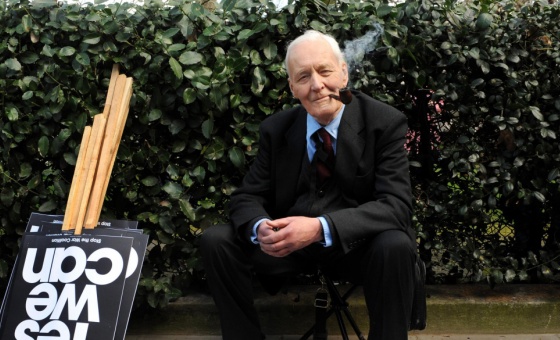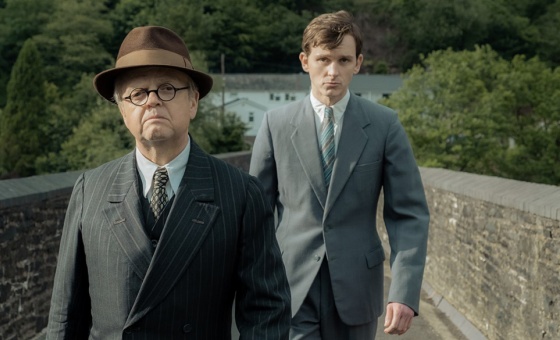This is the last article you can read this month
You can read more article this month
You can read more articles this month
Sorry your limit is up for this month
Reset on:
Please help support the Morning Star by subscribing here
YOU park your car on a dirt track in a rundown part of town. An air of neglect is as evident as the dilapidation. Overgrown weeds and stark, utilitarian concrete blocks feature next to weatherworn fences as plentiful detritus amplifies the cheerless vista.
Yet there is hope here. For this unprepossessing landscape is the site for Luton Town’s new ground, Power Court.
Luton is a club making headlines in the rarefied air of the Championship play-off final at Wembley Stadium at the end of this month, after finishing a notable third in the second tier of English football this May.
A club that rose from non-league damnation a few short years ago.
A club only 90 minutes away from the billionaires who reside in the temple to mammon that is the Premier League.
The Hatters’ outstanding achievements admirably earned without a single penny of those infernal parachute payments that distort and invariably define their division.
Money that allowed Burnley and Sheffield United to breeze back into the top flight.
Easter and the miracle of Jesus may have been and gone — Luton defeated Blackpool 3-1 on Easter Monday to continue their sprint to the play-offs — but the Hatters have risen in a story too, one that is beguiling as it is heart-warming.
Put simply, Luton is a club that refused to die, in a town that has refused to die.
The FA in their wisdom deducted points in the mid-2000s for what they said were financial irregularities. It was the unfortunate catalyst for three relegations in a row that saw the Hatters fall into the non-league maelstrom where many have been sucked deeper, yet to return.
But Luton, backed by its legion of loyal disciples, rose again, back to the promised land of league football, where they were expected to reside quietly, without fuss or rancour, simply grateful to be alive. How wrong their foes were in that assumption.
Monday May 19. Luton Town v Sunderland. Championship play-off semi-final second leg. Kenilworth Road.
You walk up the Bedfordshire town’s main drag ahead of an evening kick-off for the crucial clash with promotion rivals Sunderland at grand old Kenilworth Road.
On your walk to the evocative “Kenny” as true believers call it, along George Street — full of fried chicken joints, slot-machine parlours and pawnbrokers — where people hand out fliers for religion, for junk food products featuring little dietary fibre, for anti-knife crime initiatives, yards from where a police officer was killed in 2007, losing his life in the line of duty after responding to reports of a stabbing.
This is a place faced with the serious issues of serious crime, of drugs, gangs and violence. It is essentially an inner-city borough situated in leafy Bedfordshire. But there is nothing leafy about Luton.
It is a working-class town struggling to adapt to the post-industrial, post-lockdown world. But, like its football team, it is punching above its weight, as the nearby airport resets after the pandemic, while the traditional car industry continues to soldier through its Vauxhall car plant.
Groups of Luton fans across the town gather in beery communion before exiting the Wheelwrights Arms, the Red Lion and the Castle bar, and throatily sing exhortations in favour of their team.
They also sing ruddy songs against rivals Watford — who were previously dispatched 2-0 on Aprils Fool’s Day. Yet the only fools were the Hatters’ yellow rivals for dispensing with the services of boss Rob Edwards earlier in the season.
And when Luton’s previous boss Nathan Jones was lured by the siren song of a struggling top-flight outfit, lasting a matter of weeks before he was promptly sacked by Southampton, Luton took the progressive decision to hire Edwards.
It is no surprise then that the M1 derby which might have to be put on hold. Because, Luton — humble Luton — against all expectations, could gain promotion to the world’s richest league in a matter of days.
Imagine Luton co-existing with the petro-dollar-funded sovereign wealth of Manchester City and Newcastle, the usurious US billionaire owners of Manchester United and Arsenal, not to mention the now disgraced, previously oligarch-funded Chelsea, complete with their worthless £300m spending sprees.
The driver of a police van parked nearby eyes Luton lads warily, but they are simply boisterous supporters, buoyed by early beers ahead of the big match.
You walk past plenty of police clad in bright yellow high-vis jackets in the Bury Park area of town. A Mick Harford thunderbolt away from the “Kenny.”
Police sirens wail and a separate group stops near to a shop offering Arabic, Kurdish and Turkish food. The shop’s frontage is bright orange. The same as EasyJet, the host airline at Luton Airport. And the same colour at Luton Town’s kit.
The noise, the bustle, the sirens, the invasion of football fans into an area full of restaurants offering mouth-watering fare based on Asian street food is incongruous.
Fans walk obliviously through a community, which the club, despite genuine and steadfast efforts, has so failed to penetrate as much as its consistently large attendances would suggest.
You continue your journey.
You notice a crowd has gathered outside what you assume to be a row of houses. It is the Luton ticket office.
It is only then you look up to see the evocative, gunmetal grey steel pylons set against the sky and know you have made it to the Kenny.
The top of this functional but beautiful pylon is crowned by an assortment of geometric lamps towering over the 10,071-capacity stadium, hemmed in by tight residential streets.
No wonder places such as Kenilworth Road are deeply loved by those who care.
These types of stadiums are part of the fabric of English football gradually being swept away in the name of avarice, masquerading as evolution that is, in reality, simply a sad acceleration into corporate blandness and a crushing homogeneity that is as contrived as it is deceptive.
And while they might be tired, faded, quaint, ramshackle and uncomfortable, my word, they are full of character, offering a pulsating vibrancy and an authentic experience, as well as passionate histories complete with priceless memories, handed down across the generations via sepia-tinted stories, soaked in warm nostalgia.
The heart races with delicious excitement merely attempting to imagine this ground in the Premier League.
As kick-off nears, the queues are large, testament to the faith in Edwards’ team. The atmosphere is raw. Raucous. Passionate. And loud. Very loud.
Ninety minutes later, 90 enthralling, ear-bursting minutes later, an imperious Luton team have swept aside their Wearside counterparts 2-0 to win 3-2 on aggregate after first half goals from Gabriel Osho and their resolute defensive kingpin in a formidable back three, Tom Lockyer.
At the final whistle on Monday evening, the Kenny erupts in deep joy.
“The Town are going up,” supporters chorus lustily, as thousands race to embark in a good-natured pitch invasion, complete with orange pyro, knee slides, selfies and songs.
During the pandemic, revised plans for the Power Court stadium were approved, which included more homes and less retail space. The new 23,000-seater stadium will also host a centrally located plaza and a “statement landmark” — a tall building allowing fans to find their way to the stadium — will also be built.
But it won’t be the Kenny. It can’t be. Despite Luton’s resurrection, despite the Hatters’ unfolding miracle, Power Court won’t be Kenilworth Road. And English will die a little more.
Even if, as you head back to your car, on a dirt track in a rundown part of town, the story of Luton will be a story for the ages.
One that, if it comes true next week at Wembley with victory against Coventry City, disciples will retell with awe and no little astonishment for as long as this admirable club exists.
See the Morning Star next week for Layth’s Take on Coventry City, Luton Town’s Championship final opponents.











